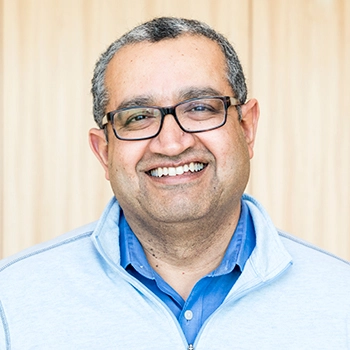In school, chemistry entranced Prakash Raman. But it was the tailoring of molecules – analyzing their structures and making strategic additions in select places – that he enjoyed most. The work was not only fascinating, but purposeful. Chemistry gave him the power to make medicine.
“I couldn’t believe that as a chemist, I could make a difference by finding new drugs for patients,” he says.
Raman, who is now Global Head of Business Development and Licensing at the Novartis Institutes for BioMedical Research (NIBR), has ended up far from the chemistry lab, but the challenges he faces each day aren’t all that different. Instead of making additions to molecules to improve their performance as drugs, he is making additions to the capabilities and resources of the entire Novartis research team to improve its ability to find new drugs for patients in need.
This career transition started early on in Raman’s Novartis career. One of his first responsibilities as a medicinal chemist was to build a molecule that would attack the hepatitis C virus by blocking part of the machinery it uses to reproduce. He and his team were in a race alongside several other companies with the same goal, so they put their heads down and worked. In the end, they produced a promising compound. But by then, a different approach to treating the virus had been discovered and had already transformed the marketplace.
“It’s no fun getting to the finish line and then realizing that the finish line has moved out of reach,” says Raman.
This experience, however, gave Raman the sense that, with broader thinking, he might be able to set better priorities and make better decisions. So when opportunities arose to take on increasingly strategic roles, he took them, first working in project management and later in strategic alliances.
“My goal is to tie everything I’ve learned over the years together to put NIBR at the forefront of doing really good deals that help Novartis fulfill its mission,” says Raman.
Raman shares more about the importance of external collaborations below.
At what point did your thinking become more strategic?

When I was on the business development team working on autoimmune and respiratory diseases, Novartis had a large pipeline, but we were lagging in immunotherapy for cancer. At that time, checkpoint inhibitors, which take the brakes off immune cells and allow them to attack cancer, were coming out with great data. It was clear that the top management wanted us to build something in this space, and they’d brought in Glenn Dranoff to lead the charge. We knew we probably needed to look externally and we needed to be bold. We worked out a strategy, mostly guided by Glenn’s expertise. What I did was overlay the external landscape, which included the actionable opportunities. When these things aligned, it was easy. The plan was like a prioritized list for the research, management and business development teams to systematically execute on.
How does the NIBR charge to collaborate externally influence your thinking?
When I was in the lab here, I always felt that we needed to be secretive about what we were doing because we were always competing with external parties. But Jay Bradner’s vision is different. He says, “Look, at the end of the day, why are we doing this? We’re doing this for patients. We need to get drugs to patients. If you find a partner or partners to help you get there faster, why not?”
That’s the mind shift we need to have internally. I think most of the new ideas popping up are really going in that direction. We have really smart people at NIBR. They’re wicked smart. So it’s more about how you harness that creativity and tie that to what’s going on in the external environment so it dovetails with our goals. Hopefully together we can really make a difference in terms of getting these medicines to patients much faster.
How much outside collaboration is too much?
It’s a balance. We can’t do everything with outside collaborators, but I also think we can’t do without them. My job is to find that innovation that’s out there that could really help what we’re trying to do internally. I’d like to marry the two – the needs of internal researchers with what’s available externally.
Where are you looking for collaborators?
My goal is to widen our geographic reach well beyond Cambridge, Massachusetts, to the US West Coast, Europe and Asia. There’s a lot of innovation happening all over the world. My team is focused on getting our scientists the support they need, and we want external companies and academic institutions to think of Novartis as a place where they can find a home for their ideas.
How will you find these far-flung opportunities?
There are roughly 6 000 associates in NIBR spread worldwide. Jay Bradner envisions leveraging all 6000 of them to help with this. They can have an impact by acting as ambassadors to all the different institutions in the different geographies around the world. We want them to funnel their ideas to us so that we can convert them to actionable opportunities. We need to leverage their reach. I want to be inundated with ideas that we think we should look at, so I want to encourage people to reach out to us. I love nothing better than an email from somebody who’s at a conference and is like, “I’m standing at this poster and here’s this really cool bit of science. Can we set up a meeting with them?” I love it because it’s so organic.
Main image caption: Global Head of Business Development and Licensing for research sees worldwide opportunities for collaboration to speed drug discovery. Photo by Andrea Bruce
Meet NIBR’s Business Development and Licensing Head, who is pursuing external collaborations to speed #drugdiscovery.
